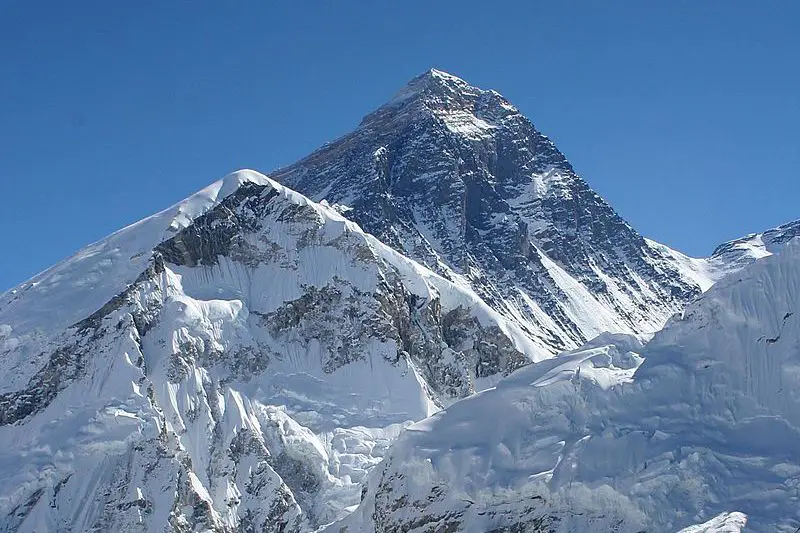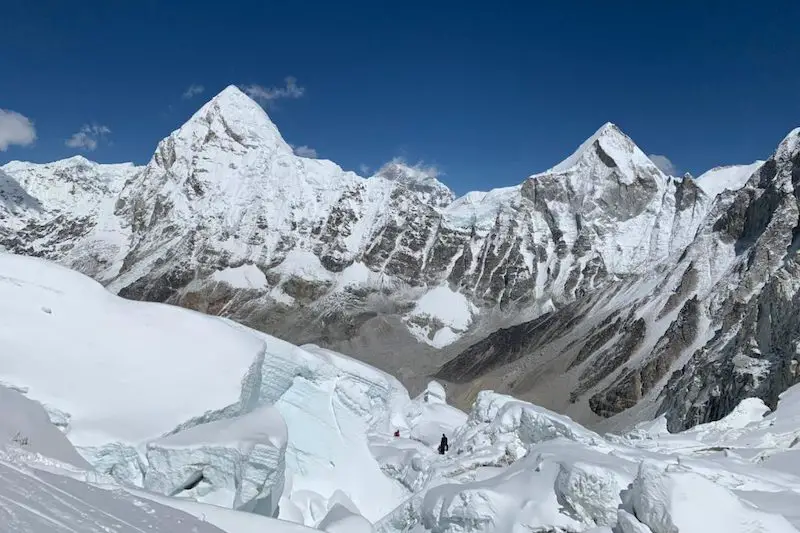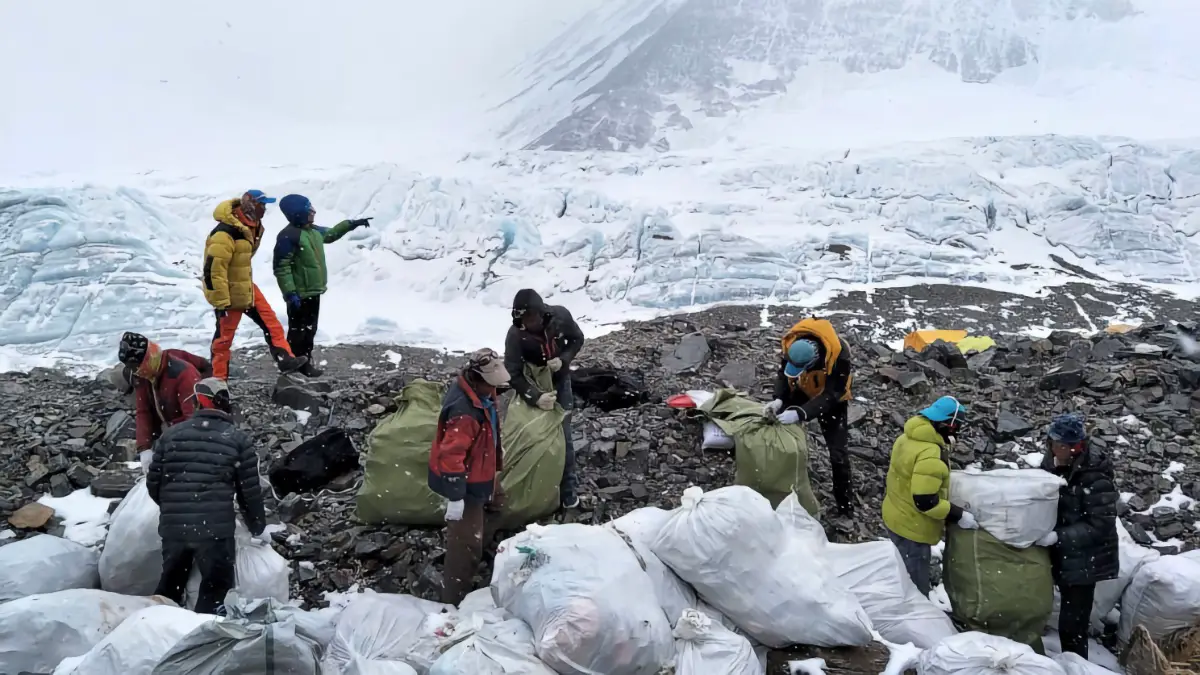Clean Trash on Everest
In recent years, there have been two persistent stories concerning Mt. Everest that the mainstream press have shared on an an annual basis. The first of those stories is just how crowded the mountain has become, while the other centers on the amount of trash on Mt. Everest that has accumulated on the Himalayan giant over the years.
While very little is being done to prevent throngs of people from flocking to Mount Everest, the world’s highest peak, each spring, removing trash and human waste from the mountain has become an annual event. This year, those efforts will be led by the Nepali military, which will send a team to scour the peak’s loft flanks.

Spring Cleaning in the Himalaya
With the spring climbing season now less than a month from getting underway, teams of climbers from around the world are preparing to descend on Kathmandu. Inside Nepal however, preparations are already well underway, with local logistical teams already heading to Everest Base Camp. After the 2020 season was canceled due to COVID, anticipation for 2021 are understandably running high. The country is looking for a big economic bounce back, even as as unrest and uncertainty grows within its borders.
One of the teams that will be heading to the Himalaya this season is a group of 43 Nepali soldiers, who are tasked with removing as much Everest trash, human waste and dead bodies as they can find and carry out. In 2019, a Nepal government expedition to Everest collected 11 tons of garbage and four bodies found in melting snow. A clean-up team of 20 Sherpa climbers collected five tons of garbage from different camps sites above the base camp and another six tons from the areas below, according to Dandu Raj Ghimire, Nepal’s Department of Tourism Director-General. So expectations are set quite high for this year’s clean up expedition.
Much of the garbage that is found on Everest base camp consists of discarded food containers and wrappers, along with discarded gear such as clothing and abandoned tents. At higher altitudes there are also a high number of depleted bottles and empty oxygen cylinders left behind by previous climbers. The non-perishable items that are recovered are flown by helicopter back to Kathmandu, where the trash is turned over to a recycling plant.
The problem with the increasing number of garbage buried in the snow and tons of waste due to lack of sanitation facilities and extreme tourism, causes too much damage to the local villagers living in the base of the mountain. Climate change is causing snow and ice to recede, reemerging buried garbage like oxygen canisters, plastic bottles, cans and human excrement or fecal matter. This is extremely bad for the local villages as pollutants are washed into rivers by rainfall and snowmelt, making the water contaminated from the Everest watershed.
For years, the Sagarmatha Pollution Control Committee (SPCC) has been working tirelessly to manage waste in Khumbu Region, which forms the Sagarmatha National Park and its Buffer Zone, and encompasses the core Everest trekking area. Established by the local Sherpa people of Khumbu in 1991, they ensure that every climb, people have legal permission to climb and educate each climber on taking care of the environment by managing their own waste.

An Unprecedented Clean Up on Five Peaks
While the pounds of trash left on Mount Everest has become a well-publicized issue, Nepal’s most famous mountain isn’t the only one that is facing environmental challenges in the Himalayan region. Since the rise of commercial climbing in the mid-1990s, many of the country’s popular climbing peaks have seen a significant influx of visitors. As a result, the natural environment of the mountains became increasingly polluted, creating a poor legacy for the mountaineering community.
Because the impact of all of those expeditions has extended well beyond Mount Everest, the military clean-up unit—assisted by a team of experienced sherpas—will be visiting five other peaks this spring as well. The expanded list of mountains includes Pumori, Ama Dablam, Makalu, Dhaulagiri, and Lhotse. Of those, Makalu, Dhaulagiri, and Lhotse are all a part of the 8000-meter club along with Everest, while Pumori and Ama Dablam are popular training peaks.
The peaks that are a part of this cleaning effort were chosen for several reasons, not the least of which is their location. All six of the mountains that are targeted for clean up can be found a relatively short distance from one another. That makes coordinating the logistics of the operation much easier, while still having the greatest impact possible.
Protecting the Himalaya for Future Generations
Mount Everest is best known as the Earth’s highest mountain towering almost 30,000 feet above sea level. The common Tibetan name of the Mountain is Chomolungma, which means “goddess mother of the world.” In Nepal, it is known as “Sagarmatha,” meaning “forehead in the sky.” And according to Dandu Raj Ghimire, the Director-General of Nepal’s Tourism Department, Everest is not just the crown of the world but their pride. And to the Sherpa people, the mountain is a sacred place, a pristine landscape that deserves dignity and respect.
The mountain may have different names and meanings to everyone but everyone has the same goal, and that is to remove the pounds of trash and tons of human waste in Everest base camp and preserve Everest from the after-effects of extreme tourism, climate change, and global warming.
While the popular press gets plenty of mileage out of headlines that decry the tons of trash and human waste climber left on the world’s highest mountain, those stories often fail to tell the full story. The Nepali government is committed to not just cleaning up the mountains, but preventing them from becoming polluted once again to restore glory to the sacred Mountain. To that end, it not only sponsors these clean-up efforts—spending more than $850,000 this year alone—but has passed regulations with strict requirements for the climbers and their support teams. Those regulations have helped alter the narrative that surrounds Himalayan climbing, which has gotten more environmentally friendly as a result.
For a number of years now, all expedition teams of climbers on the world’s highest peak have been required to carry out all of the trash and waste that they create while on the mountain. Every mountaineer is also required to pay a $4000 trash deposit initiative before the start of their climb too. That deposit is fully refundable provided the individual climber collects 17.6 pounds (8 kg) of trash on their own. When you consider that more than a thousand climbers attempt to summit Mount Everest from the Nepali side of the mountain each year, the amount of trash that is being removed starts to add up.
While there is still plenty of work to be done to reverse the damage left behind from decades of neglect, these efforts from the government of Nepal, with the help of Nongovernmental organizations such as Sagarmatha Pollution Control Committee (SPCC) , and climbers from Nepal Mountaineering Association and Everest Summiteers Association have begun to pay off. By most accounts, Mount Everest and its neighbors are in a better place now than they were just a few years ago. With ongoing clean-up campaigns set for the next few years, it is possible that we’ve turned the corner on this issue and the world’s highest peak is now returning to its former glory. That is some good news that we can all appreciate ahead of the 2021 spring climbing season.
- Gear Review: The Xero Scrambler Mid is an Ultralight Hiking Shoe for Spring - March 1, 2023
- Gear Review: Yeti Roadie 48 Wheeled Cooler - August 18, 2022
- Kristin Harila Continues Pursuit of 8000-Meter Speed Record - August 16, 2022
